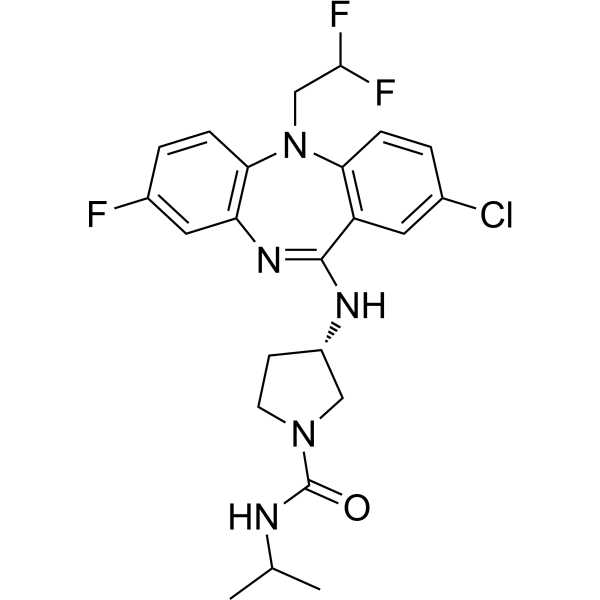NVS-PAK1-1 is a specific allosteric PAK1 inhibitor discovered in a fragment-based screen. The process of finding inhibitors that target new allosteric kinase sites is very difficult. Once identified, these compounds may provide exceptional selectivity throughout the kinome. In comparison to other PAK isoforms and the kinome as a whole, NVS-PAK1-1 exhibits high selectivity for PAK1 inhibition. The biochemical Kds for PAK1 and PAK2 in NVS-PAK1-1 are 7 nM and 400 nM, respectively. Through outstanding selectivity profile against other known kinases, NVS-PAK1-1 demonstrates outstanding activity in biochemical assays.
Physicochemical Properties
| Molecular Formula | C23H25CLF3N5O | |
| Molecular Weight | 479.925714254379 | |
| Exact Mass | 479.17 | |
| Elemental Analysis | C, 57.56; H, 5.25; Cl, 7.39; F, 11.88; N, 14.59; O, 3.33 | |
| CAS # | 1783816-74-9 | |
| Related CAS # |
|
|
| PubChem CID | 137125241 | |
| Appearance | White to off-white solid powder | |
| LogP | 4.5 | |
| Hydrogen Bond Donor Count | 2 | |
| Hydrogen Bond Acceptor Count | 6 | |
| Rotatable Bond Count | 4 | |
| Heavy Atom Count | 33 | |
| Complexity | 726 | |
| Defined Atom Stereocenter Count | 1 | |
| SMILES | CC(C)NC(=O)N1CC[C@@H](C1)N=C2C3=C(C=CC(=C3)Cl)N(C4=C(N2)C=C(C=C4)F)CC(F)F |
|
| InChi Key | OINGHOPGNMYCAB-INIZCTEOSA-N | |
| InChi Code | InChI=1S/C23H25ClF3N5O/c1-13(2)28-23(33)31-8-7-16(11-31)29-22-17-9-14(24)3-5-19(17)32(12-21(26)27)20-6-4-15(25)10-18(20)30-22/h3-6,9-10,13,16,21H,7-8,11-12H2,1-2H3,(H,28,33)(H,29,30)/t16-/m0/s1 | |
| Chemical Name | (3S)-3-[[8-chloro-11-(2,2-difluoroethyl)-3-fluoro-5H-benzo[b][1,4]benzodiazepin-6-ylidene]amino]-N-propan-2-ylpyrrolidine-1-carboxamide | |
| Synonyms |
|
|
| HS Tariff Code | 2934.99.9001 | |
| Storage |
Powder-20°C 3 years 4°C 2 years In solvent -80°C 6 months -20°C 1 month |
|
| Shipping Condition | Room temperature (This product is stable at ambient temperature for a few days during ordinary shipping and time spent in Customs) |
Biological Activity
| Targets | PAK1 (IC50 = 5 nM) | ||
| ln Vitro |
|
||
| ln Vivo |
|
||
| Cell Assay | The Caliper assay is used to quantify inhibition of PAK1 kinase activity. Microtiter plates with 384 wells are used for the assay. The test for compounds (NVS-PAK1-1) uses an 8-point dose response system. 50 nL of the compound solution in 90% DMSO is added straight into the empty plate to prepare the assays. The enzyme solution (4.5 µL) is then added to each well. The resulting solution is then pre-incubated for 60 minutes at 30°C. Finally, 4.5 µL of the peptide/ATP solution is added. Reactions are stopped by adding 16 μL of the stop solution to each well after a 60-minute incubation period at 30°C. The Caliper LC3000 workstations are used to read plates containing terminated kinase reactions. The assay used to measure product formation is called a microfluidic mobility shift. By using non-linear regression analysis, IC50 values are obtained from percent inhibition values at various compound concentrations[1]. | ||
| Animal Protocol |
|
||
| References |
[1]. Optimization of a Dibenzodiazepine Hit to a Potent and Selective Allosteric PAK1 Inhibitor. ACS Med Chem Lett. 2015 May 22;6(7):776-81. |
Solubility Data
| Solubility (In Vitro) |
|
|||
| Solubility (In Vivo) |
Solubility in Formulation 1: ≥ 2.5 mg/mL (5.21 mM) (saturation unknown) in 10% DMSO + 40% PEG300 + 5% Tween80 + 45% Saline (add these co-solvents sequentially from left to right, and one by one), clear solution. For example, if 1 mL of working solution is to be prepared, you can add 100 μL of 25.0 mg/mL clear DMSO stock solution to 400 μL PEG300 and mix evenly; then add 50 μL Tween-80 to the above solution and mix evenly; then add 450 μL normal saline to adjust the volume to 1 mL. Preparation of saline: Dissolve 0.9 g of sodium chloride in 100 mL ddH₂ O to obtain a clear solution. Solubility in Formulation 2: ≥ 2.5 mg/mL (5.21 mM) (saturation unknown) in 10% DMSO + 90% Corn Oil (add these co-solvents sequentially from left to right, and one by one), clear solution. For example, if 1 mL of working solution is to be prepared, you can add 100 μL of 25.0 mg/mL clear DMSO stock solution to 900 μL of corn oil and mix evenly. (Please use freshly prepared in vivo formulations for optimal results.) |
| Preparing Stock Solutions | 1 mg | 5 mg | 10 mg | |
| 1 mM | 2.0836 mL | 10.4182 mL | 20.8364 mL | |
| 5 mM | 0.4167 mL | 2.0836 mL | 4.1673 mL | |
| 10 mM | 0.2084 mL | 1.0418 mL | 2.0836 mL |
